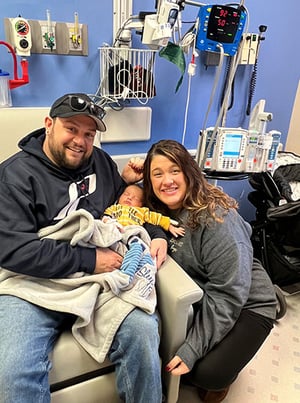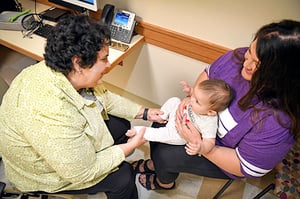
A new hope: How specialized gene therapy is helping kids with a rare genetic disorder
Camden Michael Siekert was born on a Friday — Nov. 10, 2023, to be exact. He was a few weeks early and had some jaundice, but nothing too out of the ordinary.
“Camden had a little higher levels of jaundice, so we were keeping an eye on that,” said Camden’s mom, Kristy. “His pediatrician told me if his eyes weren’t getting any better, to let them know and they’d bring him in to do another test.”
 Over that first weekend home, Kristy noticed Camden’s eyes getting more yellow and sent her doctor a message. That Tuesday morning, the doctor’s office called back and told them to bring Camden in.
Over that first weekend home, Kristy noticed Camden’s eyes getting more yellow and sent her doctor a message. That Tuesday morning, the doctor’s office called back and told them to bring Camden in.
Thinking it was just a follow-up appointment for his jaundice, Kristy stayed home with their eldest son, Cooper, while her husband, Joe, took Camden in.
So when she got a call from the pediatrician’s office a short time later, she was confused. The woman on the phone said, yes, her husband was there, but they needed her to come in too.
“The doctor needs to talk to both of you,” the woman said.
Kristy’s mind immediately went to the worst. She started panicking. She was sobbing, hysterical, terrified. What was wrong with her baby?
 The next couple hours were a bit of a blur.
The next couple hours were a bit of a blur.
She remembers arriving at the doctor’s office, but not exactly how she got there.
She remembers the large, empty room the nurse took her to.
She remembers grabbing Camden and holding him tight.
She remembers her husband holding a thick stack of papers about something called “spinal muscular atrophy.”
Just three days prior, the day after Camden was born, he underwent a standard newborn screening. A blood sample was taken with a prick of his heel and sent to the Wisconsin Department of Health Services. Among the 50 or so diseases and birth defects screened for is spinal muscular atrophy (SMA), a genetic neuromuscular disorder that causes a loss of muscle strength and control.
Camden’s test had come back positive.
Devastating diagnosis
 SMA is caused by a mutation to the survival motor neuron 1 (SMN1) gene. The gene doesn’t produce enough SMN protein and the motor neurons in the spinal cord that transfer signals between the spinal cord and the body’s muscles deteriorate. As it progresses, it can cause severe weakness, problems swallowing and difficulty breathing. In some forms, it’s fatal.
SMA is caused by a mutation to the survival motor neuron 1 (SMN1) gene. The gene doesn’t produce enough SMN protein and the motor neurons in the spinal cord that transfer signals between the spinal cord and the body’s muscles deteriorate. As it progresses, it can cause severe weakness, problems swallowing and difficulty breathing. In some forms, it’s fatal.
It is also incredibly rare, occurring in about one in every 10,000 births. In fact, Camden’s pediatrician, who had been practicing medicine for almost 30 years, had never before seen a case.
“I asked him, ‘What is this? Is my kid going to die?’ And he said, ‘Kristy, I don't know.’”
When the appointment was over, Kristy and Joe were devastated. They had just been told their 4-day-old baby would likely not make it to 2 years old. Kristy felt like she had been there for hours. In fact, it was just about 15 minutes. They walked out with Camden in their arms and an appointment with the Children’s Wisconsin Neurosciences Center for the very next day.
Back at home, that night was the longest night of Kristy’s life.
“I barely slept,” said Kristy. “I held Camden the entire night.”
 The next day, they met with Nancy Bass, MD, a pediatric neurologist with the Children’s Wisconsin Neurosciences Center who has cared for more than 50 babies with SMA in her career. They walked into that appointment with a dark cloud hanging over them. But they walked out with light and renewed hope.
The next day, they met with Nancy Bass, MD, a pediatric neurologist with the Children’s Wisconsin Neurosciences Center who has cared for more than 50 babies with SMA in her career. They walked into that appointment with a dark cloud hanging over them. But they walked out with light and renewed hope.
Dr. Bass explained all about SMA, what it is, how it affects the body, different types, treatment options and the many advancements made in the last decade. Everything Kristy had been told or read online about SMA was either inaccurate or outdated.
“I’ve been doing this a long time, and have seen a lot of kids not make it. But now you have these kids who are not supposed to be able to learn to sit, but who are now running around, jumping, running, playing, and it's unbelievable. To see a child with type 1 SMA run up to me, it's crazy, actually,” said Dr. Bass. “It’s something I never thought I would see.”
“I felt a little bit weight off my shoulders,” said Kristy. “On the way home, I laughed for the first time.”
That night, around 8 p.m., Kristy’s phone rang with a Children’s Wisconsin caller ID. It was Dr. Bass, just checking in to see how she was doing.
“That was amazing, because that's not something a doctor has to do,” said Kristy. “I'm forever grateful we were able to meet with Dr. Bass and get the care at Children's Wisconsin.”
Three options
 At that first appointment with Dr. Bass, she laid out three treatment options. The first was a drug called Spinraza, which is delivered every four months through a spinal tap. The second was a daily oral medication called Evrysdi. And the third was a one-time gene therapy called Zolgensma.
At that first appointment with Dr. Bass, she laid out three treatment options. The first was a drug called Spinraza, which is delivered every four months through a spinal tap. The second was a daily oral medication called Evrysdi. And the third was a one-time gene therapy called Zolgensma.
“When she went through all those options, we immediately knew we were going to choose the gene therapy,” said Kristy.
“Gene replacement therapy, or gene transfer therapy, is really the wave of the future for lots of genetic diseases, including SMA,” said Dr. Bass, who is also a professor of neurology at the Medical College of Wisconsin, the academic partner of Children's Wisconsin. “It sounds a little bit like science fiction. They take a gene that's missing and they put it into a virus. Babies get an IV and we've now given them the gene they're missing, which can then produce the protein that's missing. It has been a miracle treatment.”
Three weeks later, Camden came back to Children’s Wisconsin for his treatment.
“It was a very emotional day for us,” said Kristy. “Everyone was so kind, so welcoming, so warm.”
Kristy and Joe held Camden while the nurse placed an IV. Over the next hour, while Camden slept, they watched the medicine drip down until it was all gone. The care team monitored Camden for the next few hours and then they were ready to go home.
That was it.
Renewed hope
 Today, Camden is 8 months old and loving life.
Today, Camden is 8 months old and loving life.
“He’s the best baby,” said Kristy. “He’s smiley and talkative. He has such a light. He’s perfect.”
Since Camden didn’t have any symptoms before his treatment, it’s difficult to gauge how well the gene therapy is working. But in the seven months since the infusion, he has shown no signs or symptoms. If you didn’t already know he had this disease, you never could tell.
“He didn't have any symptoms, so we're just hoping that he never does,” said Kristy. “To the naked eye, you would think he's a perfect, healthy baby.”
With SMA, time is crucial. The sooner it can be diagnosed and treated, the better the outcome. For Camden, he was diagnosed at 4 days old and received treatment at 26 days. When you take into account he was born three weeks early, this was just about the best case scenario.
“If you can catch a baby before they show symptoms, and treat them with the gene replacement as soon as possible, there is a much better outcome,” said Dr. Bass. “Every day you're waiting, that motor neuron is degenerating and dying off. The sooner you can get them treated, the better. Camden was diagnosed quickly and got treatment very quickly, so he has an excellent prognosis.”
With any new, cutting-edge treatment, it’s impossible to know exactly what the future will hold. Gene replacement therapy has only been treating SMA for less than a decade, so there’s no way to know what 10, 15, 20 years into the future looks like for these kids. But at a bare minimum, the treatment has given these families hope where very recently there was none.
“I would be lying if I said I didn't still have moments,” said Kristy. “We’ll be at a park and see families with kids running around, tossing the football together, and I’ll say, ‘I really hope that will be Cooper and Camden one day.’ And my husband tells me, ‘It will be.’”
Children's Wisconsin Resources

Written by
Evan Solochek
Writer
Related Stories
No related articles found.



